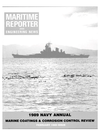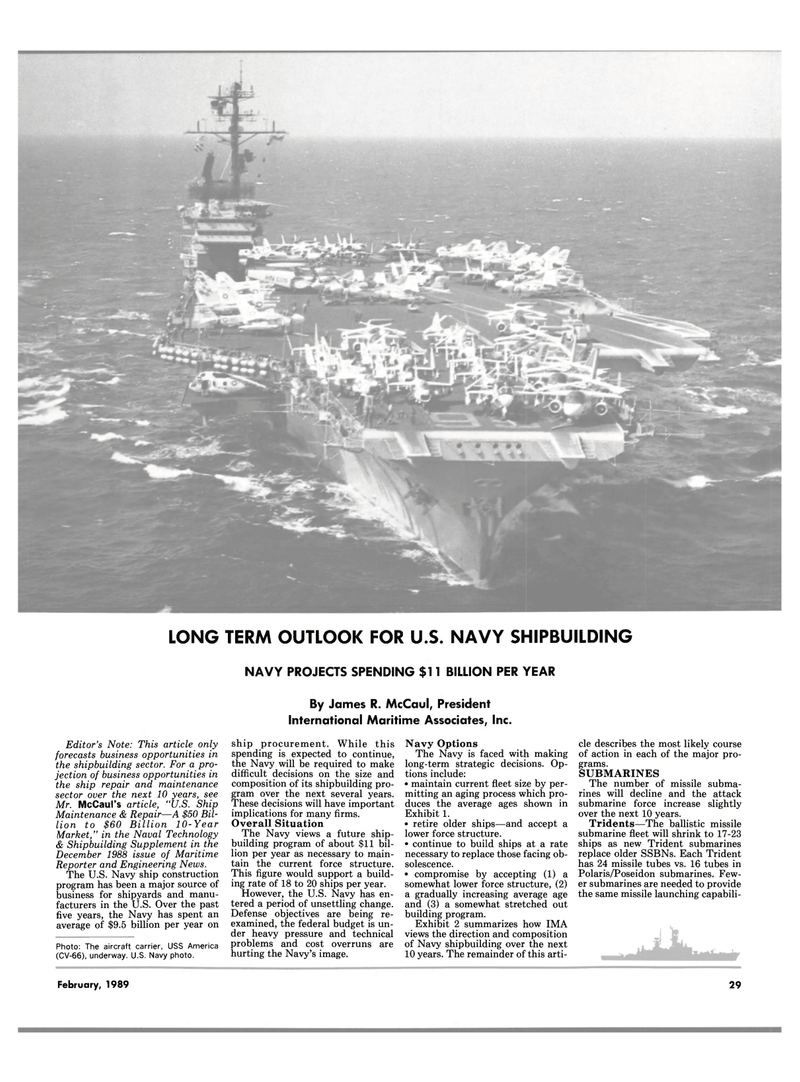
Page 27: of Maritime Reporter Magazine (February 1989)
Read this page in Pdf, Flash or Html5 edition of February 1989 Maritime Reporter Magazine
LONG TERM OUTLOOK FOR U.S. NAVY SHIPBUILDING
NAVY PROJECTS SPENDING $11 BILLION PER YEAR
By James R. McCaul, President
International Maritime Associates, Inc.
Editor's Note: This article only forecasts business opportunities in the shipbuilding sector. For a pro- jection of business opportunities in the ship repair and maintenance sector over the next 10 years, see
Mr. McCaul's article, "U.S. Ship
Maintenance & Repair—A $50 Bil- lion to $60 Billion 10-Year
Market," in the Naval Technology & Shipbuilding Supplement in the
December 1988 issue of Maritime
Reporter and Engineering News.
The U.S. Navy ship construction program has been a major source of business for shipyards and manu- facturers in the U.S. Over the past five years, the Navy has spent an average of $9.5 billion per year on
Photo: The aircraft carrier, USS America (CV-66), underway. U.S. Navy photo. ship procurement. While this spending is expected to continue, the Navy will be required to make difficult decisions on the size and composition of its shipbuilding pro- gram over the next several years.
These decisions will have important implications for many firms.
Overall Situation
The Navy views a future ship- building program of about $11 bil- lion per year as necessary to main- tain the current force structure.
This figure would support a build- ing rate of 18 to 20 ships per year.
However, the U.S. Navy has en- tered a period of unsettling change.
Defense objectives are being re- examined, the federal budget is un- der heavy pressure and technical problems and cost overruns are hurting the Navy's image.
Navy Options
The Navy is faced with making long-term strategic decisions. Op- tions include: • maintain current fleet size by per- mitting an aging process which pro- duces the average ages shown in
Exhibit 1. • retire older ships—and accept a lower force structure. • continue to build ships at a rate necessary to replace those facing ob- solescence. • compromise by accepting (1) a somewhat lower force structure, (2) a gradually increasing average age and (3) a somewhat stretched out building program.
Exhibit 2 summarizes how IMA views the direction and composition of Navy shipbuilding over the next 10 years. The remainder of this arti- cle describes the most likely course of action in each of the major pro- grams.
SUBMARINES
The number of missile subma- rines will decline and the attack submarine force increase slightly over the next 10 years.
Tridents—The ballistic missile submarine fleet will shrink to 17-23 ships as new Trident submarines replace older SSBNs. Each Trident has 24 missile tubes vs. 16 tubes in
Polaris/Poseidon submarines. Few- er submarines are needed to provide the same missile launching capabili-
February, 1989 29

 26
26

 28
28
